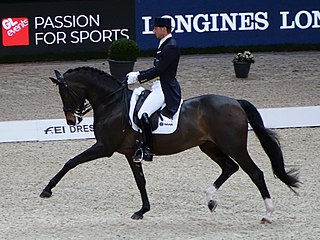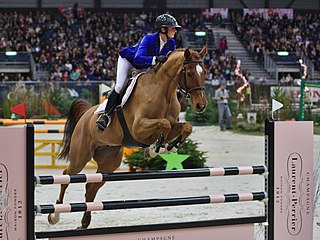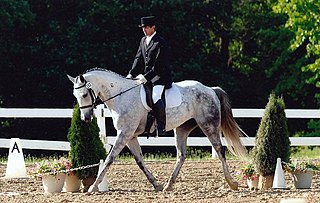
The Kinsky Horse is a Czech breed of warmblood sport horse. It was bred by the Kinsky family in the Kingdom of Bohemia, and is now one of four warmblood sport horse breeds reared in the Czech Republic, the others being the Czech Warmblood, the Slovakian Warmblood and the Moravian Warmblood. It was for many years absorbed into the Czech Warmblood; a separate stud-book was established in 2005. It is characterised by an unusual golden-yellow coat, though other colours are also seen.

The Brandenburger is a German breed of warmblood sport horse from the state of Brandenburg in north-eastern Germany. From the 1960s – when Brandenburg was in East Germany – it was included in the stud-book of the Edles Warmblut or 'light warmblood'. Following the re-unification of Germany it again had its own stud-book. In 2003 it was included in the stud-book of the Deutsches Reitpferd, which also included the Sachsen-Anhaltiner Warmblut, the Sächsisches Warmblut and the Thüringer Warmblut; the Bavarian Warmblood, the Württemberger and the Zweibrücker were added to it in 2014.

The Ukrainian Riding Horse or Ukrainian Saddle Horse is a modern Ukrainian breed of warmblood sport horse. Breeding began in the years after the Second World War at the stud farm of Dnipropetrovsk in central Ukraine – at that time in the USSR – and later expanded to three other state stud farms. It derives from cross-breeding of Hanoverian, Thoroughbred and Trakehner stallions with local mares or with Hungarian Furioso, Gidran Arab or Nonius mares. It incorporates the last bloodlines of the extinct Orlov-Rostopchin or Russian Saddle Horse. It was bred to compete in show jumping, three-day eventing and dressage, but is also suitable as a general riding horse.

The Knabstrupper or Knabstrup is a Danish breed of warmblood horse. It is principally a riding horse, but is also used as a harness horse and as a circus animal. It is broadly similar to the Frederiksborger, but often has a spotted coat. In the past, injudicious breeding for this characteristic alone compromised its constitution and conformation. In the years after the Second World War the mechanisation of agriculture led to a sharp fall in numbers, and by the 1960s no more than 100 of the horses remained. In the twenty-first century it is an endangered breed, with a world-wide population estimated at little over 2000.

The Czech Warmblood, Czech: Český Teplokrevník, is a modern Czech breed of warmblood sport horse.

The Freiberger or Franches-Montagnes is a Swiss breed of horse of light draught type. It originates in the Canton of Jura in north-western Switzerland, and is named for the Freiberge or Franches-Montagnes District in the south of that canton. It is widely distributed in Switzerland, and is also present in France and Belgium.

The Danish Warmblood or Dansk Varmblod is a Danish breed of modern sport horse, established in the mid-twentieth century and used mainly for dressage and show-jumping. Like other European warmblood breeds, it is a performance breed: any suitable horse of any origin may be admitted if it passes a strict performance test. Hanoverian, Holsteiner, Swedish Warmblood and Trakehner are among those that have contributed to the breed.

The Swedish Warmblood or Swedish Half-bred is a Swedish breed of warmblood horse. It was originally bred as a cavalry horse at the Strömsholm, Ottenby and Flyinge studs. In the twentieth century it became a general-purpose riding and sport horse. It performs well in dressage, show-jumping and three-day eventing, and also as a harness horse.

The Swiss Warmblood or Schweizer Warmblut is a modern Swiss breed of warmblood sport horse. It was created in the mid-twentieth century by merger of the Einsiedler – which had been bred for centuries at the Benedictine Monastery of Einsiedeln in the Canton of Schwyz – with the Swiss Halfblood and with traditional local breeds including the Ajoie, the Erlenbacher and the Entlebucher. It is sometimes known as the Neue Einsiedler. The Swiss Warmblood is bred at the Haras National Suisse at Avenches, in the Canton of Vaud.

The Brazilian Sport Horse or Brasileiro de hipismo is a modern Brazilian breed of warmblood horse. It was bred as a sport riding horse for competitive equestrian sports, particularly show jumping, dressage and three-day eventing.

The Hungarian Sport Horse, Hungarian: 'Magyar sportló', is a modern Hungarian breed of sporting horse. Like the Furioso-North Star, the Gidran, and the Nonius, it was developed at the Hungarian State Stud Mezőhegyes, in Békés county in the Southern Great Plain region of south-eastern Hungary. At the end of 2012, the total number for the breed was reported to be 1091. The breeders' association is the Magyar Sportlótenyésztők Országos Egyesülete, or Association of Hungarian Sporthorse Breeders.

The Latvian Horse is a purpose-bred warmblood horse breed from Latvia. Breeding began in Latvia in the early twentieth century, and a herd book was established in 1927. The breed was officially recognised in 1952. There are two types, sometimes called the Latvian Harness Horse and the Latvian Riding Horse. The harness type was predominant until about 1960, when demand for sport horses increased and more of the saddle type were bred.

The Gelderlander is a Dutch breed of warmblood horse. It was bred in the province of Gelderland in the Netherlands as a carriage horse capable also of farm work. It declined in popularity in the mid-twentieth century. In 1965 it was one of the foundation breeds of the Dutch Warmblood or KWPN, the other being the heavier Groninger horse from the north. It is registered in a division of the Royal Dutch Warmblood Horse Studbook, which also has divisions for the Dutch Warmblood and for the Dutch Harness Horse.

The Rottaler is a German breed of riding and carriage horse of heavy warmblood type. The name derives from that of the Rottal, the valley of the Rott in the Landkreis of Rottal-Inn in south-eastern Bavaria. It is critically endangered. The Bavarian Warmblood derives from it.

The Rhenish Warmblood, German: Rheinisches Warmblut or Rheinisches Reitpferd, is a German warmblood breed of sport horse. It is traditionally bred at the Warendorf State Stud, which it shares with the Westphalian, and is bred to the same standard as the Westphalian and other German warmbloods, such as the Bavarian Warmblood, Mecklenburger, Brandenburger, and Württemberger.

The Estonian Native,, is an Estonian breed of small horse. It is strong and is resistant to disease. It is one of three recognised horse breeds in Estonia, the others being the Tori and the Estonian Draft, both of which derive from it. It has also influenced other Northern European breeds such as the Latvian Warmblood, and the Vyatka and the extinct Obva in Russia. It is an endangered breed; the population fell from about 16000 in the 1950s to approximately 500 in 2004.

The Silesian Warmblood or Silesian, Polish: Koń śląski, Silesian: Ślůnski kůń, is a Polish breed of warmblood horse. It originates in the historic region of Silesia in south-western Poland. It is the heaviest of the Polish warmblood breeds. It has been influenced mainly by the Oldenburger, and to some extent also by the East Friesian, the Hanoverian and the Thoroughbred.

The Schleswig Coldblood is a breed of medium-sized draught horse originally from the historic Schleswig region of the Jutland Peninsula, which today is divided between modern Denmark and Germany, and from which its name derives. It is found primarily in the northern German state of Schleswig-Holstein, and also, in smaller numbers, in Lower Saxony. It shares the origins, ancestry and much of the history of the Danish Jutland breed, and shows some similarity to the British Suffolk Punch. It is used in agriculture and forestry, and to draw coaches and wagons.

The Belgian Sport Horse, Dutch: Belgisch Sportpaard, French: Cheval de Sport Belge, is a Belgian breed of warmblood sport horse. It is one of three Belgian warmblood breeds or stud-books, the others being the Belgian Warmblood and the Zangersheide. It is bred for dressage, for show-jumping and for three-day eventing.

The Zangersheide is a Belgian breed or stud-book of warmblood sport horses. It is one of three Belgian warmblood breeds or stud-books, the others being the Belgian Sport Horse and the Belgian Warmblood.




















